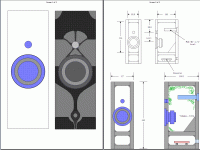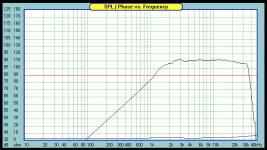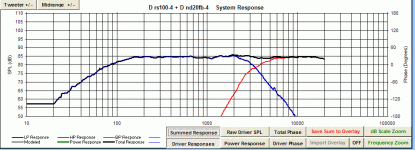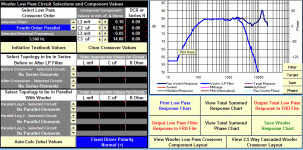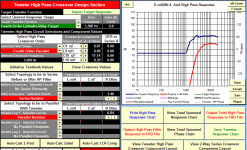I wish to build a cheapish "reference" system using Dayton drivers.
rs100-4
nd20fb-4
I designed the enclosure around Zaph's specs, fr graph found here:
Click on rs100-4.
Click on nd20fb-4.
The formulas for the ported enclosure:
DIYaudiocorner.
The box will be made out of 3/4'' MDF and will have a rather large separate chamber for the crossover, which will also make the box taller.
The crossover will be set at ~3,000Hz to ~3,500Hz.
If the response graphs and formulae are accurate, I should end up with an almost ruler flat speaker that should look rather nice.
Open to suggestions.
P.S. (The bad thing is that the small peak is going to be right in the middle of the sensitive hearing range...)
rs100-4
nd20fb-4
I designed the enclosure around Zaph's specs, fr graph found here:
Click on rs100-4.
Click on nd20fb-4.
The formulas for the ported enclosure:
DIYaudiocorner.
The box will be made out of 3/4'' MDF and will have a rather large separate chamber for the crossover, which will also make the box taller.
The crossover will be set at ~3,000Hz to ~3,500Hz.
If the response graphs and formulae are accurate, I should end up with an almost ruler flat speaker that should look rather nice.
Open to suggestions.
P.S. (The bad thing is that the small peak is going to be right in the middle of the sensitive hearing range...)
Attachments
Last edited:
When I clicked on your links they came up as a pair of Scanspeak drivers .
I think the rule of thumb is to cross a tweeter over no lower than 4x it's resonance
frequency so for this tweeter with a resonance of 2072hz that comes out to ~8k.
I would think you would be better off just using the woffer and using a notch filter
for that 10 to 12 db peak at 16k.
I think the rule of thumb is to cross a tweeter over no lower than 4x it's resonance
frequency so for this tweeter with a resonance of 2072hz that comes out to ~8k.
I would think you would be better off just using the woffer and using a notch filter
for that 10 to 12 db peak at 16k.
You have to actually click on the driver name 
Zaph's comparision application is a javascript application, so I can't link directly to the Daytons. You have to click on the driver name in that list (woofer is near bottom left, tweeter bottom right) or else you will only see the first driver, i.e. the Scanspeak.
Damn about the tweeter - is there any reason for not going lower than 4*Fs?
Zaph's comparision application is a javascript application, so I can't link directly to the Daytons. You have to click on the driver name in that list (woofer is near bottom left, tweeter bottom right) or else you will only see the first driver, i.e. the Scanspeak.
Damn about the tweeter - is there any reason for not going lower than 4*Fs?
I'm listening to the RS 100-8 right now. What an awesome little speaker! Forget that tweeter unless you have the hearing of a bat. The 16k peak isn't even troubling for my dog. I know I sure don't hear well up that high and nether do most people. Heck, most people can't hear anything that high and there's a good chance you are one of them if you are over 30, male and you've behaved like a typical guy at any point in your life. The power response of that peak is even going to make it less audible and the fact that it doesn't ring makes it a non issue. It may actually help make the speaker sound flat if anything.
The more important end to put Augmentation on is the lower end. These speakers run out of gas quickly on the low end. This driver makes for excellent augmentation on the cheap: Parts-Express.com:*Peerless 830634 10" SLS Woofer | Peerless P830634 10" driver SLS Woofer subwoofer bass mid midbass mtm 2-way Tymphany genelec 342-6001 2-way 3-way midrange mid vifa studio monitor active
You'll quickly get over your $100 limit, but only by a bit and a year from now you'll be so happy you did.
I'm running the RS100-8 and the Peerless 10" SLS on a 40cm wide by 75cm tall open baffle with absolutely incredible results. I almost hate telling you about it b/c I kind of want to buy more of those Peerless buyouts--even though I have no purpose for them.
More on the design: I just got this up and running last night and it's not complete, but this is a good starting point. I'm actively crossed over 24dB/octave 4th order LR and just over 200Hz. There's a 6dB baffle peak right above the x-over, but the little driver has started it's roll-off at this point anyway. The little speaker is around 67cm off the floor and 3.8cm off center and the woofer is 40 or 45cm off the floor centered on the baffle. The basics of the design come from here: http://www.quarter-wave.com/OBs/OB_Design.pdf
My wife said that this combination sounds as good or possibly slightly better than any of the Tannoy Heritage speakers we heard while on holiday in Akiba-Tokyo, Japan with much more expensive equipment behind them. They are many thousand USD. I'd actually say the same when comparing this design to the Feastrex field coil on the Nelson Pass's BOB speaker I just heard at Burning Amp. In some ways I'm sure I prefer these--the price! Actually I think I may prefer the sound as well, but there are too many variables to say resolutely. After hearing these things it's really apparent how much speakers have limited my system up until this point. Actually I bet they're still the most limiting part even if less limited than ever before. I mean they are very inefficient and are probably compressing peaks, the crossover hasn't been optimized, the FRers haven't been flush mounted, the openings and baffle edges are not rounded over yet, etc... So there's still a long way to go before they are finished, but they are a class act for $60 in drivers per side. Clever implementation of the tweeter you mentioned might just be the icing on the cake, but definitely not the most relevant first augmentation to start with if you plan on listening at normal, moderate levels. I really think if you do what you're planning on doing you'll regret it in a week. I can listen very loud with this pair if I want to. No way, no how with the FRer going into the low end. Another thing, don't forget that power response may be (I now think it is) the most important factor in speaker design. Narrow OB does power response better than most designs.
I can listen very loud with this pair if I want to. No way, no how with the FRer going into the low end. Another thing, don't forget that power response may be (I now think it is) the most important factor in speaker design. Narrow OB does power response better than most designs.
I hope this helps,
Dan
The more important end to put Augmentation on is the lower end. These speakers run out of gas quickly on the low end. This driver makes for excellent augmentation on the cheap: Parts-Express.com:*Peerless 830634 10" SLS Woofer | Peerless P830634 10" driver SLS Woofer subwoofer bass mid midbass mtm 2-way Tymphany genelec 342-6001 2-way 3-way midrange mid vifa studio monitor active
You'll quickly get over your $100 limit, but only by a bit and a year from now you'll be so happy you did.
I'm running the RS100-8 and the Peerless 10" SLS on a 40cm wide by 75cm tall open baffle with absolutely incredible results. I almost hate telling you about it b/c I kind of want to buy more of those Peerless buyouts--even though I have no purpose for them.
More on the design: I just got this up and running last night and it's not complete, but this is a good starting point. I'm actively crossed over 24dB/octave 4th order LR and just over 200Hz. There's a 6dB baffle peak right above the x-over, but the little driver has started it's roll-off at this point anyway. The little speaker is around 67cm off the floor and 3.8cm off center and the woofer is 40 or 45cm off the floor centered on the baffle. The basics of the design come from here: http://www.quarter-wave.com/OBs/OB_Design.pdf
My wife said that this combination sounds as good or possibly slightly better than any of the Tannoy Heritage speakers we heard while on holiday in Akiba-Tokyo, Japan with much more expensive equipment behind them. They are many thousand USD. I'd actually say the same when comparing this design to the Feastrex field coil on the Nelson Pass's BOB speaker I just heard at Burning Amp. In some ways I'm sure I prefer these--the price! Actually I think I may prefer the sound as well, but there are too many variables to say resolutely. After hearing these things it's really apparent how much speakers have limited my system up until this point. Actually I bet they're still the most limiting part even if less limited than ever before. I mean they are very inefficient and are probably compressing peaks, the crossover hasn't been optimized, the FRers haven't been flush mounted, the openings and baffle edges are not rounded over yet, etc... So there's still a long way to go before they are finished, but they are a class act for $60 in drivers per side. Clever implementation of the tweeter you mentioned might just be the icing on the cake, but definitely not the most relevant first augmentation to start with if you plan on listening at normal, moderate levels. I really think if you do what you're planning on doing you'll regret it in a week.
I hope this helps,
Dan
Usualy you don't cross over any where near the resonance frequency because the
impedience peaks at that frequency. This makes designing a crossover harder.
yes you are not suppose to cross near the Fs but 3500hz is almost an octave over the Fs (the Fs of the Dayton Neo is not consistent, I measured from 1600hz to 2000hz). LR4 (24db/octave slope) will work fine. I would use the RS100-4 because it has more sensitivity.
yes you are not suppose to cross near the Fs but 3500hz is almost an octave over the Fs (the Fs of the Dayton Neo is not consistent, I measured from 1600hz to 2000hz). LR4 (24db/octave slope) will work fine. I would use the RS100-4 because it has more sensitivity.
Changing impedance may mean it's been getting warm.
Chris
>>> Actually I bet they're still the most limiting part... I mean they are very inefficient and are probably compressing peaks, the crossover hasn't been optimized, the FRers haven't been flush mounted, the openings and baffle edges are not rounded over...
Below is my sub $100 'reference' speaker.
http://www.zillaaudio.com/pioneerb20-piezo.htm
I enjoy it peaks, dips and all. At this price point it's really about finding a sound you enjoy and listening to your music.
Godzilla
Below is my sub $100 'reference' speaker.
http://www.zillaaudio.com/pioneerb20-piezo.htm
I enjoy it peaks, dips and all. At this price point it's really about finding a sound you enjoy and listening to your music.
Godzilla
Last edited:
>>> Godzilla, can I ask what my post that you quoted has to do with your post?
Hi Dan, i am just reinforcing that these are inexpensive speakers at under $100. The quote i took from your post describes what you have built and some of the compromises involved when building speakers at this price point.
"inefficient and are probably compressing peaks, the crossover hasn't been optimized, the FRers haven't been flush mounted, the openings and baffle edges are not rounded over..."
A reference speaker at this price point IMO can only be one with compromises as you described. Doesn't mean they won't sound good.
Godzilla
Hi Dan, i am just reinforcing that these are inexpensive speakers at under $100. The quote i took from your post describes what you have built and some of the compromises involved when building speakers at this price point.
"inefficient and are probably compressing peaks, the crossover hasn't been optimized, the FRers haven't been flush mounted, the openings and baffle edges are not rounded over..."
A reference speaker at this price point IMO can only be one with compromises as you described. Doesn't mean they won't sound good.
Godzilla
Oh, gotcha. I wasn't sure what you were getting at (why I asked), but I didn't take any offense. ; >) Sorry if I sounded abrasive. It wasn't my intention. It's easy to come off that way from time on the web. Actually I'm well over $100 on the system by $20 on just the drivers, and when you figure in active crossover and extra amp.... The only part that can't be fixed for free is the efficiency--if that's even a problem. For most people It probably isn't. I don't think anyone with a SET is looking to buy 80 something dB speakers. The rest is just work--a lot of work. Oh yea, and good luck trying to build a decent passive crossover for this set up and stay cheap. Caps and inductors in those values are pricey. The cost of it just doesn't seem worth it vs. going active, but it could be argued that it is. In any case, I was trying to give what I think is a better design with the MR driver chosen, not for under $100.
If I were being strict with the $100, I'd probably build something like what you've done with the pioneers or a similar speaker as well. Those look good BTW! I've got to have a little volume, and those will do it. The last time I heard those (not in your build) I remember thinking they were way better than their price.
I've bottomed the little Daytons out on some pretty quite (by my standards) music running FR in a sealed box. I never got over the experience and always felt a bit nervous when they were playing. They did a little better with a 100uF electrolytic cap inline and I couldn't hear any difference in bass output. Their bass output is just that weak. The system they are in now is quite remarkable and in the same league as the best I've heard up to this point. It is impressive given it's cost/size and ease of build. Of course right now that's just my opinion--until someone else goes for it.
Dan
If I were being strict with the $100, I'd probably build something like what you've done with the pioneers or a similar speaker as well. Those look good BTW! I've got to have a little volume, and those will do it. The last time I heard those (not in your build) I remember thinking they were way better than their price.
I've bottomed the little Daytons out on some pretty quite (by my standards) music running FR in a sealed box. I never got over the experience and always felt a bit nervous when they were playing. They did a little better with a 100uF electrolytic cap inline and I couldn't hear any difference in bass output. Their bass output is just that weak. The system they are in now is quite remarkable and in the same league as the best I've heard up to this point. It is impressive given it's cost/size and ease of build. Of course right now that's just my opinion--until someone else goes for it.
Dan
Usualy you don't cross over any where near the resonance frequency because the
impedience peaks at that frequency. This makes designing a crossover harder.
Usually. There's tweeters which doesn't have big bumb in impedance.Here is tweeter which has peak at 500 Hz only rising couple of ohms.
THE ART OF SOUND PERFECTION BY SEAS - H1189-06 27TDFC
I'm listening to the RS 100-8 right now. What an awesome little speaker! Forget that tweeter unless you have the hearing of a bat. The 16k peak isn't even troubling for my dog. I know I sure don't hear well up that high and nether do most people. Heck, most people can't hear anything that high and there's a good chance you are one of them if you are over 30, male and you've behaved like a typical guy at any point in your life. The power response of that peak is even going to make it less audible and the fact that it doesn't ring makes it a non issue. It may actually help make the speaker sound flat if anything.
I'm 18 and can hear pretty well, definitely up to 17,500Hz before either my hearing drops out or the speakers we used to play with in Physics don't go past that. (Apparently they cost $600, seemed pretty good, but not $600)
I have a belief that if a speaker can go up to 33,000Hz, it will be able to better handle all the waveforms that are piled on top of each other in the waveform. For $8 each, I may as well have them (the tweeters) anyway, even if for another project.
The more important end to put Augmentation on is the lower end. These speakers run out of gas quickly on the low end. This driver makes for excellent augmentation on the cheap: Parts-Express.com:*Peerless 830634 10" SLS Woofer | Peerless P830634 10" driver SLS Woofer subwoofer bass mid midbass mtm 2-way Tymphany genelec 342-6001 2-way 3-way midrange mid vifa studio monitor active
You'll quickly get over your $100 limit, but only by a bit and a year from now you'll be so happy you did.
I'm running the RS100-8 and the Peerless 10" SLS on a 40cm wide by 75cm tall open baffle with absolutely incredible results. I almost hate telling you about it b/c I kind of want to buy more of those Peerless buyouts--even though I have no purpose for them.
More on the design: I just got this up and running last night and it's not complete, but this is a good starting point. I'm actively crossed over 24dB/octave 4th order LR and just over 200Hz. There's a 6dB baffle peak right above the x-over, but the little driver has started it's roll-off at this point anyway. The little speaker is around 67cm off the floor and 3.8cm off center and the woofer is 40 or 45cm off the floor centered on the baffle. The basics of the design come from here: http://www.quarter-wave.com/OBs/OB_Design.pdf
I would do something like that, but I have space issues at the moment, so I might need to settle for a sub woofer when I really need bass. Would that suffice as a sub? Or maybe the TB 6''?
My wife said that this combination sounds as good or possibly slightly better than any of the Tannoy Heritage speakers we heard while on holiday in Akiba-Tokyo, Japan with much more expensive equipment behind them. They are many thousand USD. I'd actually say the same when comparing this design to the Feastrex field coil on the Nelson Pass's BOB speaker I just heard at Burning Amp. In some ways I'm sure I prefer these--the price! Actually I think I may prefer the sound as well, but there are too many variables to say resolutely. After hearing these things it's really apparent how much speakers have limited my system up until this point. Actually I bet they're still the most limiting part even if less limited than ever before. I mean they are very inefficient and are probably compressing peaks, the crossover hasn't been optimized, the FRers haven't been flush mounted, the openings and baffle edges are not rounded over yet, etc... So there's still a long way to go before they are finished, but they are a class act for $60 in drivers per side. Clever implementation of the tweeter you mentioned might just be the icing on the cake, but definitely not the most relevant first augmentation to start with if you plan on listening at normal, moderate levels. I really think if you do what you're planning on doing you'll regret it in a week.I can listen very loud with this pair if I want to. No way, no how with the FRer going into the low end. Another thing, don't forget that power response may be (I now think it is) the most important factor in speaker design. Narrow OB does power response better than most designs.
I hope this helps,
Dan
Loud is not so much of a problem, listening at full output of my 1W portable DIY speaker doesn't happen often, as a reference.
Now, about this phase thing: Zaph's fr graph shows hardly any impedance change as Fs for the nd20fb-4. The manufacturer's specs only show a 2 Ohm increase; is this fine?
By the way, thank-you everyone for your replies so far.
Attachments
OK, so you will probably want to add a tweeter and that one looks like a simple one judging by the impedance curve and size. I'm certainly no crossover expert, so you may want to go one to the FRD Consortium site and download some programs to get you where you need to go. Post these questions over on Tech Talk on the Parts Express website. There should be some people over there with experience with these drivers. I gotta tell you though, they do look fairly easy to get right b/c of the range they cover and the size. Heck, after looking at that I may even add a tweeter to mine for my wife's enjoyment. On second thought, never mind. Too many issues integrating tweeters. The ear is very sensitive at the crossover frequencies usually selected so getting the hand off inaudible is tough. If you move out of the range where the ear is sensitive, the tweeter can't handle it on the low end and the wavelength is small on the upper end that the midrange speaker is the beaming and driver integration is difficult. That's why I chose to augment the low range. In any case if you find a way to get this tweeter and MR to combine well, I would be most interested!
So you NEED:
1) small size
2) low volume
3) FR > 33kHz--an interesting idea and is it a believe or a hypothesis or a theory............ do tell please. I think I know where you're going with this, but I want to know. Tantalizing stuff.
4) under $100 total? or just on drivers?
How low do you want the Freq Resp to go? Anything else that should be on this list?
nice project,
Dan
So you NEED:
1) small size
2) low volume
3) FR > 33kHz--an interesting idea and is it a believe or a hypothesis or a theory............ do tell please. I think I know where you're going with this, but I want to know. Tantalizing stuff.
4) under $100 total? or just on drivers?
How low do you want the Freq Resp to go? Anything else that should be on this list?
nice project,
Dan
Last edited:
I'm aiming for:
1) Small size (Mini towers for use on desktop, ~40cm high)
2) Low volume due to small size (up to 10L, I used 3L based on specs)
3) < FR > 33kHz--an interesting idea and is it a believe or a hypothesis or a theory............ do tell please. I think I know where you're going with this, but I want to know. Tantalizing stuff. >
I think it's about how well the tweeter may play many frequencies that ride on top of each other, for example, it may be able to better play 3 bands playing at once, knowing how jumbled up that would sound anyway...
4) Under $100 on drivers, as I can get the C's,R's and L's from Altronics or Jaycar.
5.) How low do you want the Freq Resp to go?
I'd say 80Hz for a start, I can probably build a subwoofer for it later. When I have my own house and need something for the lounge, I will build another pair of speakers that go down lower; I may use the Daytons again if they perform well.
6.) Anything else that should be on this list?
Hmmm...easy to build? At this stage I'm going to be cheating on the circles by using a jigsaw and file unless I can get a cheap GMC router or similar. I'll have to wait until after my exams before I buy anything, so there probably won't be much progress for about a month...at least I'll have time to review the design, etc.
1) Small size (Mini towers for use on desktop, ~40cm high)
2) Low volume due to small size (up to 10L, I used 3L based on specs)
3) < FR > 33kHz--an interesting idea and is it a believe or a hypothesis or a theory............ do tell please. I think I know where you're going with this, but I want to know. Tantalizing stuff. >
I think it's about how well the tweeter may play many frequencies that ride on top of each other, for example, it may be able to better play 3 bands playing at once, knowing how jumbled up that would sound anyway...
4) Under $100 on drivers, as I can get the C's,R's and L's from Altronics or Jaycar.
5.) How low do you want the Freq Resp to go?
I'd say 80Hz for a start, I can probably build a subwoofer for it later. When I have my own house and need something for the lounge, I will build another pair of speakers that go down lower; I may use the Daytons again if they perform well.
6.) Anything else that should be on this list?
Hmmm...easy to build? At this stage I'm going to be cheating on the circles by using a jigsaw and file unless I can get a cheap GMC router or similar. I'll have to wait until after my exams before I buy anything, so there probably won't be much progress for about a month...at least I'll have time to review the design, etc.
Nice idea on the 33K. Sounds sensible to me. If I could hear as high as you I'd try it. I mean those tweeters are cheap and perform well by most accounts. Many of the negative reviews I see look like user error more than tweeter issues.
I use a jigsaw on my holes--just be slow and patient and exact an they will easily do. I like to put a thin piece of hardboard overtop of the cutout for a rebate. Just cut the same hole in the hardboard as the cutout, place the speaker through both holes, draw a ring around the speaker, cut that hole out, mount the speaker, glue the rebate/hardboard on to test for fit and glue it in place. you only have to do this if the speaker is intended to play above 5k or so. Opinions vary on that number, but I don't think anyone would say woofers need it unless there very close to the tweeter.
A small ported box with the Dayton FRer and said tweeter looks to fill your bill and later you can add a woofer or subwoofer. It would be great to get a build diary!
Keep us up to date,
Dan
I use a jigsaw on my holes--just be slow and patient and exact an they will easily do. I like to put a thin piece of hardboard overtop of the cutout for a rebate. Just cut the same hole in the hardboard as the cutout, place the speaker through both holes, draw a ring around the speaker, cut that hole out, mount the speaker, glue the rebate/hardboard on to test for fit and glue it in place. you only have to do this if the speaker is intended to play above 5k or so. Opinions vary on that number, but I don't think anyone would say woofers need it unless there very close to the tweeter.
A small ported box with the Dayton FRer and said tweeter looks to fill your bill and later you can add a woofer or subwoofer. It would be great to get a build diary!
Keep us up to date,
Dan
Update: I've been using Passive Crossover Designer and have managed to get a fairly flat response.
Woofer crossed over at 3500Hz, tweeter at 3300Hz. (With 4dB attenuator)
Does this response look ok? Please request more details if needed.
One more question: should I use Zaph's FR graphs or the Dayton ones?
Woofer crossed over at 3500Hz, tweeter at 3300Hz. (With 4dB attenuator)
Does this response look ok? Please request more details if needed.
One more question: should I use Zaph's FR graphs or the Dayton ones?
Attachments
Last edited:
- Status
- This old topic is closed. If you want to reopen this topic, contact a moderator using the "Report Post" button.
- Home
- Loudspeakers
- Multi-Way
- === "$100 Reference System" ===
